Reawaken The Woman Within

Welcome!! Before we begin....
We officially start week commencing 24th May but here's a few things to do before we begin....
Join the Facebook Group and introduce yourself to your new community here https://www.facebook.com/group...
Save this Zoom link as it will be used for all our one to one and group coaching calls - Join Zoom Meeting https://us02web.zoom.us/j/6520...Meeting ID: 652 009 1121Passcode: 8QyTY6
Week 1 - Understanding the principles of Ayurveda
How we are manifested in the world:
Purusha - this is the pure consciousness, it is the ultimate truth, the observer, the witness, the ultimate healing power, the ultimate enlightenment which we may have glimpsed in our meditation practice. This is masculine in nature.
Prakruti - this is divine will, creation, the womb space, the divine mother, the creator, the beautiful chaos within life. This is feminine in nature.
Mahad - When Purusha and Prakruti come together they create Mahad. Mahad is supreme intelligence, the intelligence of every single one of our cells, the intelligence that allows us to breathe, grow, learn. The intelligence that knows what to do with fuel and minerals in the body. Our collective intelligence.
Ahamkara - this is the feeling of "I am", that I have a boundary, that I am different to you. It is often translated as ego but not in the Freudian sense. This is a healthy parameter that knows we live in our enclosure of consciousness. Our accumulated experience of this existence - our individual intelligence.
The energy of the universe (prana) then causes the ultimate consciousness to breakdown into three elements (gunas) within us - Sattva, Rajas and Tamas - these will be discussed in more detail later in the course.
What Ayurveda teaches us is when we are in conflict with our Ahamkara, we create "dis"ease in the body.
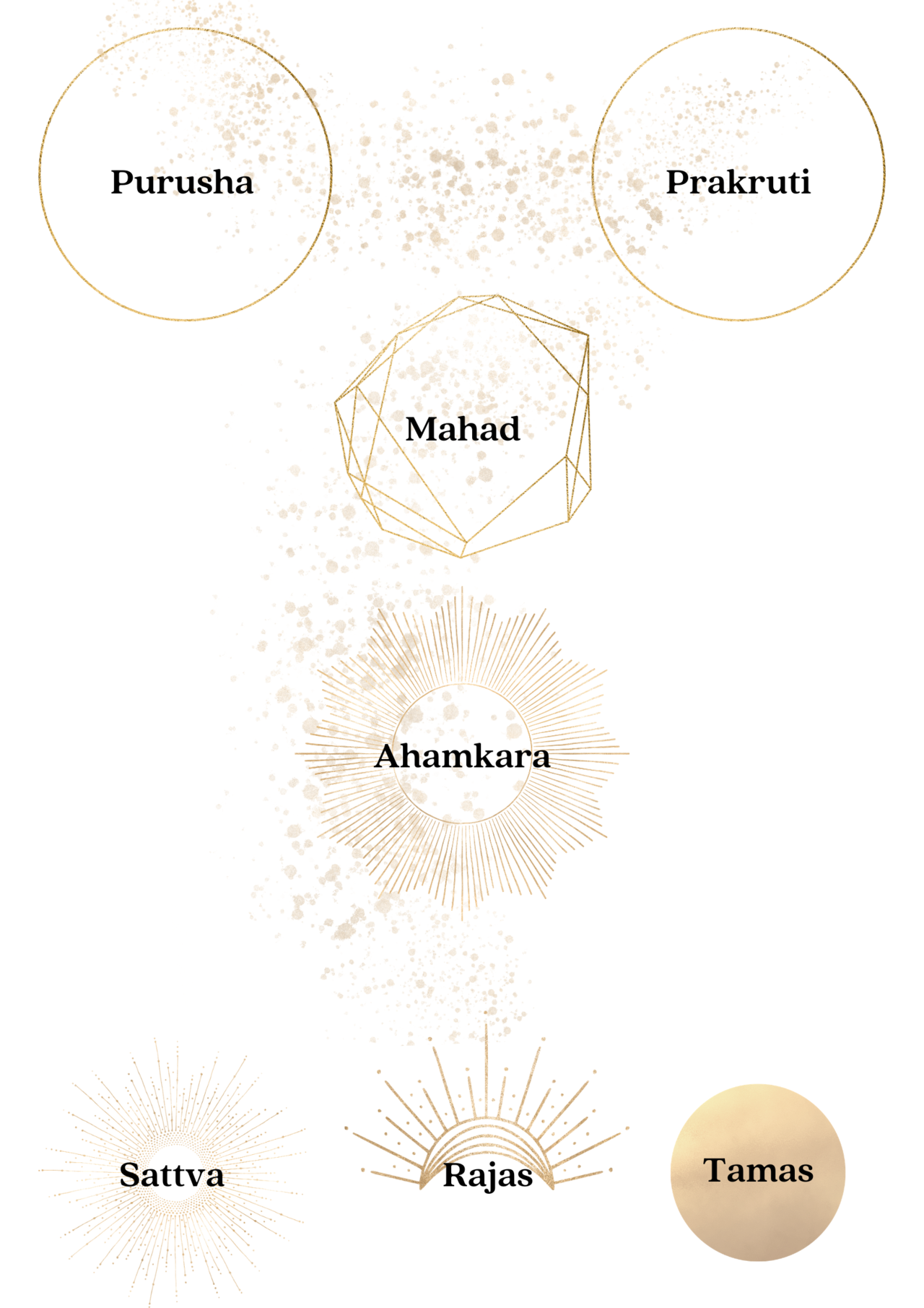
Putting the teachings into practice
I want you to spend some time this week really getting to know yourself. We now know that who you truly are (not what others tell you you are), including the parts you are not fond of, were the idea of the divine. You were meant to be exactly as you are to serve your purpose in this world - your dharma.
Spend some time this week journaling this. You may want to use the following prompts and get really clear on the beautiful impact you were created to have on this world. If you have not tried journaling before, find a quite space, spend a couple of minutes with your eyes closed connecting to your breath and write out one of the prompts below and just write - see what comes up for you. You will be amazed by the beautiful wisdom that is available within you.
1: What are the parts of my nature that I love and serve me and others in this world?
2: What are you parts of my nature that I don't enjoy so much and why is this?
3: Where have others told me about my "faults" and how has this influenced how I see myself?
4: Knowing I was created exactly as I am to serve this world, how could I view these parts of myself differently?
5: Knowing myself as I truly am, what might that tell me about my purpose in this world?
6: How can I embrace who I truly am going forward so I share all of me with the world?
Week 2 - Understanding the doshas
Understanding Prakriti and Vikriti
Hello lovely. This week we will look at how to eat and live inline with your own personal constitution. Here you will find a quiz (https://www.dropbox.com/s/juvf...) to help you establish your own natural mix of the doshas.
The doshas are patterns that manifest in the body - we are born with a unique pattern of the doshas and these go out of balance as we go through the course of our lives but the aim is to come back to our original nature - our original state of balance.
Think of them as indicators that tell us when we are going out of balance so the key is to eat inline with the dosha that is presenting most strongly for you at the time.
Eating to balance kapha dosha:
Eat only when you are genuinely hungry and not in between meals. Avoid overeating, especially in the evening kapha types can thrive on two meals a day, so you can afford to skip breakfast if you are not hungry or just have a fresh vegetable juice made with ginger. Favour foods that are light, dry or warm to counter fluid retention and congestion. For example grains such as barley, corn, millet, buckwheat and rye. Raw food is viewed as cold and damp and is best minimisedFavour foods that are spicy, bitter or astringent such as steamed, green, leafy vegetables rich in the bitter taste, prepared with warming garlic and ginger. Fresh ginger is especially helpful for kapha types. You can take a pinch of fresh ginger root daily with a few drops of lemon juice as an appetiser before each mealOther key herbs to warm the digestion are black pepper, cumin, cinnamon, cardamom, cloves, and turmeric. Try adding these spices to your cooking to invigorate a sluggish kapha digestion Reduce foods that are heavy (eg: red meat), oily/fatty (eg: nuts, crisps, biscuits, cakes, fried foods) or cold (eg: yoghurt, cheese)A largely vegetarian diet is recommended. If you eat meat, favour white meats and take some brisk exercise after eating to help the digestion processReduce foods that are sweet (refined sugars, chocolate), salty and sour in taste. A little honey is the best sweetener for this typeAvoid raw or refrigerated foods as well as iced drinksMinimise alcohol which is sweet and sour in nature. Enjoy hot, spicy warming drinks with herbs such as ginger, cinnamon and fennel.:
Eating to balance pitta dosha:
Aim for three good meals a day. Eating at consistent times from one day to the next also helps to balance an overactive digestive fire
Favour sweet, bitter and astringent tastes which are cooling and refreshing- such as fresh fruits and vegetables, rice, quinoa, spelt, barley, oats, milk, butter, ghee, foods rich in the bitter tastes include green, leafy vegetables, rhubarb and rocket
Raw foods tend to be naturally cooling, and pitta tends to be able to handle them better than the other doshas, so mixing in an assortment of raw fruits and vegetables will generally be supportive—especially in the warmer months. Try not to mix raw and cooked foods in the same meal
Avoid hot and spicy foods such as those cooked with chillies, raw onion, raw garlic, mustard and cayenne.
Minimise the sour taste, for example, foods such as cheese, yoghurt and tomatoes are considered especially sour
Minimise your use of salt and salty foods such as salted nuts and crispsThe best oils for Pitta are olive, sunflower and coconut oil, as well as ghee or unsalted butter. Avoid fried and greasy foods and low-quality oils
Favour the milder spices such as fresh ginger, fennel, coriander, turmeric and small amounts of black pepper. Some key cooling and calming herbs you can use to help balance your strong digestion are coriander, and mint. You can use these herbs liberally in your cooking and as cooling garnishes
Favour all the sweet fruits but avoid the sour tasting ones such as oranges, grapefruits and pineapples. Lemon and lime are fine in moderation
Limit your intake of stimulants such as alcohol, coffee. Instead, drink cool drinks and minty, refreshing herbal teas. Include cooling and calming Aloe Vera juice in your daily diet
Eating to balance vata dosha:
Establish a routine of regular meal times, ideally three or four times a day
Try not to get distracted while you are eating and instead create a calm, relaxed atmosphere for meal times so you can concentrate on your meal
Favour foods that are warm, soupy, heavy and oily- think soups, stews, casseroles and other one-pot dishes
Some key warming herbs for vata to help balance your digestion, are fennel, turmeric, cinnamon, cumin, dill, black pepper, and cardamom.
Favour foods that taste sweet, sour and salty as these are most nourishing for you. Note that this doesn’t mean refined sugar but foods which are considered energetically sweet such as rice, spelt, kamut, oats, quinoa, root vegetables, sweet fruits and organic dairy
Try to minimise white sugar. The best sweeteners for this type are honey, molasses, barley malt and maple syrup
Increase your intake of good quality natural oils - hemp, sesame, olive, sunflower and flax are all ideal. Cooking with butter and ghee helps to moisten dry foods but avoid fried and greasy foods
Stimulants such as alcohol, coffee, black tea and fizzy drinks can all be aggravating for this type. Take plenty of warm water and spicy and relaxing herbal teas.
Minimise foods that are cold, dry and hard - such as crackers, rice cakes, crisps, and dried fruits and nuts (unless they have been soaked)
Minimise foods that are very spicy such as chillies, bitter like coffee or astringent like raw apples, most beans/pulses except mung beans, red lentils and marinated tofu
Avoid raw food, cold and frozen foods as much as possible, such as ice cream and iced drinks.
Things to journal on this week:
1. What dosha generally shows up when I am out of balance?
2. What are the things I am doing that might be causing this?
3. What changes can I make to prevent this from happening?
And here is a bonus training to help you start thinking about the doshas wider than just in the sense of food......
Week 3 - Dinacharya
Your daily routines
MORNING
Starting the Day Off With Love for Yourself.
Your daily routine begins the night before: Getting in bed by 10 or 10:30 PM (which can be a little later in the summer) will help you start the morning off right.
Wake up at sunrise: If you are exhausted, sick or elderly, please sleep as long as you like. Upon waking, do not get out of bed right away. Try to be aware of your body and feel grateful to be alive before your toes touch earth.
Gently scrape your tongue: Buy a stainless steel tongue scraper. Scrape from back to front 5-8 times. The tongue is a mirror of your intestines. When there is a thick white coating on the tongue, it is indicative that ama (toxins) is present. Tongue scraping helps prevent diseases of the oral cavity, improves our ability to taste, gets rids of old food debris and prevents bad odor in the mouth.
Wash your face, mouth, teeth and eyes: Splash your face with cool water. Wash the eyes with cool water or real-deal rose water. You can also buy an eye cup at most pharmacies for washing the eyes. Massage your gums with sesame oil. This improves oral hygiene, prevents bad breath, increases circulation to gums, heals bleeding gums and helps us maintain strong healthy teeth.
Drink warm lemon water: This helps to wash the GI tract, flushes the kidneys and stimulates peristalsis. If your digestion is sluggish, add 1/2 tsp ginger root powder or grated fresh ginger.
Nature calls: Going to the bathroom upon waking will help clear your digestive system. A healthy movement will have a soft brown log quality, little odor, and will be well formed (like a banana). Undigested food, foul odor, mucous, excessive dryness or pellet-like quality suggests a digestive imbalance. Altering diet, lifestyle and using herbs will help better this.
Use a neti pot. Add 1/4 teaspoon of salt to warm water in the pot and drain through each nostril. Afterwards, put 3-5 drops of warm sesame oil or ghee in the nostrils to lubricate the nose. This keeps the sinuses cleans, improves voice, vision and mental clarity. Our nose is the door to the brain. Nose drops nourish our prana and enhance intelligence.
Abhyanga (self-massage)—massage is one of our greatest allies for total health. It nourishes and soothes the nervous systems, stimulates lymphatic flow and aids in detoxification. It also improves circulation, increases vitality, nourishes the skin and promotes body/mind balance.
Exercise: One of greatest allies in moving toward balance, exercise boosts the immune system and is an excellent way to counteract depression. Exercise daily to half capacity. We want to get a little sweaty glow but not burn out before our day begins.
Bathe: Use natural products.
Meditation: Begin your day with some form of breathwork and meditation.
Start with five minutes and work up to at least 20 minutes daily. I sometimes do my meditation before exercise. This is also fine.
Eat breakfast.
AFTERNOON/EVENING
Try to make lunch your biggest meal of the day. Eat in a pleasant, calm place without distraction.
Take some time to bless the food prior to eating.
After eating, if you can lie down on your left side for 5-20 minutes, this is ideal.
Why? Because it helps the digestive organs to do their work to assimilate the meal.
If you are at work, even just leaning to the left side in your chair will be helpful.
One afternoon routine that helps you deeply relax into your evening is the practice of yoga nidra—a yogi nap. It’s also nice to do this prior to dinner, just before sunset.
Eat light at night—Having your last meal before sundown, and at least 3 hours before bedtime will ensure better sleep. For more about sleep, see our nighty-night routines.
NIGHTY-NIGHT
Ayurveda offers an ideal way for transitioning from the activity of the day into the sacred chamber of sleep. Following these routines will make sleep come effortlessly, and will help keep you asleep through the night:
Set the mood—Depending on the season (in the winter it may be earlier), start turning off overhead lights after dinner. Avoid fluorescent lights always, but especially at night. Low lighting helps tell your body it is time to go to sleep. Lots of light confuses your circadian rhythms and messes with the natural hormones that pull you into the “sleepy feeling.” Switch to low level lighting, candles, or install dimmers on your overhead lights to set the mood for sleep.
No more screen-time—Set an intention to turn off all screens (computers, cellphones, TVs) by 8 or 9 PM. Experts state that when we are exposed to artificial lighting (such as computer and smartphone screens), the sleep-promoting hormone melatonin is suppressed, making us feel more alert and changing our circadian rhythms. Be in bed by 10 PM.
Take a warm bath—Taking a scented warm bath can help reset the nervous system towards sleep. Use oils such as frankincense, myrrh, lavender, honeysuckle, chamomile, neroli or pure rose for deep slumber.
Avoid too much mental stimulation—Don’t watch evening news. It’s toxic for your dreams. Similarly, avoid planning your future, having intense conversations or any other activity that promotes mental movement before bed.
Light a candle, read a sweet book that makes your heart melt. Say some prayers or offer thanks/gratitude, and turn in.
Unravel the day—There is a powerful meditative practice for unraveling the day. It actually builds your power of assimilation and boosts memory. Once in bed and lying down, mentally go backward through your day in increments of 30 minutes. Try to simply register what was happening to you during the day without judgment. Notice your feelings, relax and let all events go. End with the point where you woke up in the morning. Gently drift into sleep.
Week 4 - Prana, Tejas and Ojas
Subtle Ayurveda
Prana, Tejas and Ojas are the more subtle energetic forms of the doshas.
All should be at optimal level which corresponds with your prakruti.
If we consider this in the body - there is an intelligence in each cell in your body (Tejas), the intelligence flows and communicates with other cells (Prana) and medium that holds the flow is Ojas.
Prana is the purest essence of Vata dosha and the element of Ether - It is life energy. You may have heard it called Ki or Chi in other traditions. one of the functions is our respiratory system - we inhale the cool air and exhale the warm. In Ayurveda breath can be used to alter dosha imbalances (we will discuss this in a later training). It is pure awareness and awareness is manifested as thought, feelings and emotions. To witness these without seperation or judgement is what allows for healing.
Tejas is the purest essence of Pitta dosha and the element of Fire - it is pure intelligence. The intelligence that transforms what we take in and experience - our food, liquids, thouughts, actions, emotions. Tejas give colour to our aura, eyes look bright, hair and skin glow. It is eternal - it is your true nature.
Ojas is the purest essence of Kapha dosha and the element of Water - it is related to our vitality and immunity. Ojas fights against aging and disease. If you Ojas is good, you rarely become sick - it is your natural immunity. One of it's functions is to maintain the tissues in our bodies and the doshas. The quality of Ojas depends on your digestion, lifestyle, stress, traumas and quality of relationships. In Ayurveda we know a health relationship is a good tonic.
Prompts to assimilate learning:
Prana
- Notice your emotions throughout the week - what emotions do you avoid, supress and hold on to?
- Can you witness without judgement?
- How does this change their intensity, your bodys response, how long they last?
Tejas
- Notice throughout the week where are you saying yes where you want to say no?
- Where are you saying no where you want to say yes? What are you longing to do but don't due to reasons/logic/stories you are telling yourself
- What are your actions saying about your relationship to yourself and your worth?
Ojas
- What does a healthy relationship mean to you?
- What is the quality of your relationship with your partner/close friends?
- Are there relationships you hold on to but know they are not healthy?
Break week

We have covered a lot already so far, so I invite you to take this week to take stock, review what we have covered and set your intentions for the next few weeks ahead.
Just a reminder - there are no group calls this week.
Week 5 - Agni
What is it and how can it be regulated?
Our agni is our ability to digest - food, emotions, experiences etc. To take one component and turn it into something that we need. It is our transformational fires.
In Ayurveda there are 3 main types of agni:
- Regulate Jatharagni (Gut)
- Regulate Bhutagni (Liver)
- Regulate Dhatu Agni (Tissues)
There are 5 main ways we can regulate agni:
- Reduce Stress
- Regulate Jatharagni (Gut)
- Regulate Bhutagni (Liver)
- Regulate Dhatu Agni (Tissues) - discussed in a future lesson
- Reduce Ama - discussed in next lesson
This week we are focusing on the top 3:
Reduce Stress
- Identify level of stress & stressors (stress clock)
- Take steps to reduce stress - Incorporate healthy daily routines/
sense therapies, Asana-Pranayama-Meditation (Exercise-Breathe-Relax) - Address stressors - Eliminate exposure to stressors or make a strategy to prepare for and recover from exposure to stressors
Regulate Jatharagni (Gut)
1. Identify state of agni
2. Address state of agni - Regular mealtimes, Healthy eating habits - mindful eating
3. Appropriate food choices - Shop for the season, Cook for the Dosha, Fresh, whole, organic, local (when possible)
4. Avoid hormone disruptors
5. Spicing & Herbal Supplementation
Regulate Bhutagni (Liver)
1. Avoid liver challenging foods (alcohol/sugar/fatty foods/processed foods)
2. Increase greens
3. Love your Liver - 15 ways to Love your Liver
Week 6 - Ama
What us it and how to shift it....
Signs of Ama include:
Feeling of loss of energy or strength
Feeling of heaviness in the bodyLaziness/no motivationIndigestionExcessive salivationExcess mucus productionTiredness/Brain fogDisturbance in bowel movement and eliminationReduced appetiteBad breathCoated tongueGeneralized body ache (dull type pain)Depression with long-lasting sadness
Cleansing
We cleanse to remove ama - to stabilize digestion, reduce/eliminate digestive challenges, clear the blood of toxins, clear and revitalize body tissues, support all of the body’s major cleansing organs (liver, kidneys, colon, skin, etc.) and to alkalise our acidic diet. Don't worry - YOU GET TO EAT FOOD And fats. And even a little meat if you need it. Basically, it’s just healthy eating that will give you body he opportunity to reset. Firstly you need to commit to 3 - 7 days of clean eating and clean living. Here’s the recommendation on what you will be eating/not eating:1. 80% Green: Every meal will be 60-80% vegetables. Greens are great (cooked kale, collards, any cruciferous veggies, spinach, salads, etc.) You may want to add in some roots like carrots, beets, etc. Avoid too many root vegetables that are sugar rich. Moving to an 80% plant-based diet turns on more than 500 genes that create health, and switch off more than 200 genes that create cancers. Green juices and smoothies are fine in moderation.2. Dairy: Avoid during the cleansing 3. Grains: Quinoa is great (it’s not a grain!), but keep to 1/2 to 1 cup with meals. Kitchari is also a great option, especially if you are vegetarian and is made with basmati rice. (recipe below)4. Mung beans: 1/2 cup with meals (so if you are eating kitchari-recipe below-you could have 1 whole cup with each meal because it’s the rice and beans.) Try to limit kitchari to one cup per meal.5. Spices: cardamom, cumin, fresh or dry ginger, cinnamon, salt, cloves, mustard seed, black pepper, aesofetida, fenugreek, turmeric, coriander, fennel, cumin, dill, mint, turmeric, parsley are all good.6. Sugar: Zero. No honey, stevia, soft drinks, no artificial sweeteners. We need to let it go because it creates an addiction in the system. After the cleanse you can move back into sweets like fruits, honey and other natural sweetness in moderation.7. Fats and Protein: Totally great if they are “good fats”-Omega-3 rich foods, avocados, nuts(no peanuts), and coconut, ghee, butter or olive oil. No processed vegetable oils. Only cook with coconut or ghee. Use the others raw! Good quality proteins are allowed (lean organic, grass-fed meats and fish, etc.) but eat sparingly. Fish is the best option, but look for small, wild caught so as to avoid mercury toxicity. Personally I would avoid meat during the cleanse. If you are eating it, it meats only in the middle of the day when the digestive fire is high.8. Fruits: Just lemons and limes although avocado and tomatoes are fine.9. Coffee/tea: Try to cut out coffee and tea. If it’s not possible, this is the least of my concern. If you are doing coffee, do it with some fat like coconut oil or butter. I recommend cutting back slowly instead of cold turkey.10. Bone or veggie broth: For thousands of years there have been traditional foods like bone broths for deep cleansing and reconstitution of the gut. Bone both helps with almost all forms of digestive imbalance, aids in overcoming food intolerances and allergies and boosts the immune system. Bone broths are incredibly nutrient-dense, easy to digest, rich in flavour and great for cleansing. The simmering causes the bones and ligaments to release healing compounds like collagen, proline, glycine, and glutamine. Researchers explain that bone broths contain minerals in forms that your body can easily absorb: calcium, magnesium, phosphorus, silicon, sulphur and others. They contain chondroitin sulphates and glucosamine, the compounds sold as pricey supplements to reduce inflammation, arthritis and joint pain. Bone broth is super easy to make (recipe below) but it is important that you get bones from a grass-fed source with no hormones/antibiotics/chemicals, etc. If you are vegetarian, you can also make veggie broths!
So, a typical cleanse day might look like this:
1. Morning lemon water with 1 tablespoon of coconut oil + 1/4 tsp. ginger and 1/4 tsp. turmeric first thing in the A.M.
2. Bone broth, vegetable soup or alkalizing green drink (see recipes below) first thing in the A.M.
3. Around 9 or 10 AM some nuts or salmon with coconut oil/butter on some cucumber slices or a small bowl of kitchari.
4. Lunch-80% cooked veggies and/or salad with oil and apple cider vinegar. 1 small bowl of kitchari OR a small piece of fish or lean meat.
5. Dinner-Large bowl of steamed or grilled veggies with a small side of quinoa. OR a bowl of kitchari with steamed veggies and coconut oil with sunflower seeds. If you can do bone broths, great. Don’t go hungry, but I find that if I eat enough fat, sometimes I’m not even hungry at night. Refrain from eating after 6 pm if possible.
FEEL FREE TO DESIGN YOUR OWN CLEANSE AND YOUR OWN MENU BASED ON THE ALLOWED ITEMS.
Other considerations:Begin each day with warm water with lemonPlan time each morning to prepare food for the day Aim to have meals at consistent times daily, spaced at least 3 hours apart. Have your final meal no later than 7 p.m.Drink water (with lemon or lime is fine) or herbal teas throughout the dayAllow adequate time for sleep; ideally go to bed/wake up at the same time dailyAvoid excessive exercise and sexual activity Limit direct exposure to the elements Be mindful of your use of electronic devices
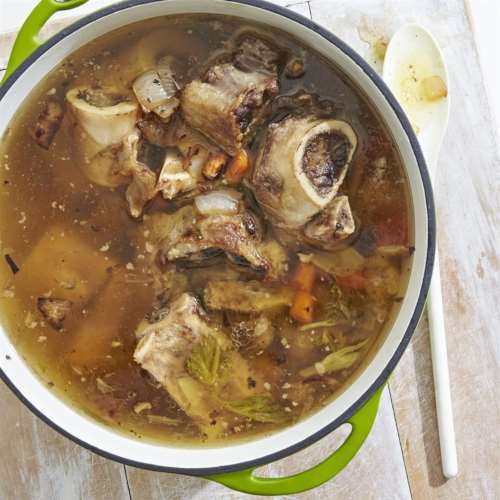
RECIPES
Alkalizing Green Drink for Morning• 1/2 to a whole cucumber with skin• a few large green leaves (lettuce, collard, watercress, etc.)• small piece fresh ginger (half thumb size)• 1 teaspoon-1 tbs. coconut or MCT oil• 2 stalks celery• 1 c. water• 1/2 cup Aloe Vera juice. Blend in blender on high for 30 seconds.
Kitchari - Mung beans scrape the intestines and alkalize the system which supports cleansing of toxins. Please make your kitchari in a pressure cooker if you can. Beans are best pressure cooked-this removes the lectins from them, otherwise they create digestive upset. If you can’t buy a pressure cooker (they are pretty affordable on Amazon!), then soak them at least overnight and cook until totally liquid and follow the directions below. If you DO have a pressure cooker, simply add all ingredients and cook for 15-20 minutes as per desired consistency (mushy to not as mushy). • 1 tsb. ghee • 1 and 1/2 tsp spice seeds • 1 and 1/2 tsp powdered spices • 2 and 1/2 cups water • 1/4 cup organic basmati rice• 1/4 cup organic mung beans • 1-2 cups fresh, seasonal, organic vegetables, cut into small pieces • 1 tsp. coriander seed powder • 1/4 tsp rock salt. Rinse and soak mung beans. Rinse cup basmati rice. Take ghee and melt into pan. Add spice mix (choose 2 from cumin seed, mustard seed, fennel, fenugreek). Heat ghee in sauce pan until seeds pop. Add in the powdered herbs (choose from turmeric, garam masala, curry powder, cinnamon, ginger, cardamom, etc, “Italian herbs,” etc.). Add rinsed/soaked mung beans and rice. Stir to coat with oil and spices. Heat through. Add hot water and bring to a boil. Add 1-2cups chopped vegetables and greens. Simmer on medium-low for 30-45 minutes. Other options: Mung Beans with Carrots, Saffron-Asparagus Kitchari, Kale with Sunflower Seeds, Mung Bean Vegetable Soup, Roasted Veggies with Lemon and Spice.
Digestive Teas: Fennel, Cumin, Coriander seeds (savoury): Take 1 tsp. each and place into 1 and 1/2 cups cold water. Bring to a boil. Remove from heat and let cool to drinking temperature. Strain to drink.
Ginger/Fennel (sweet and warm): Use a coin sized piece of ginger and 1 tsp. fennel seeds. Mince fresh ginger. Add herbs to 1 and 1/2 cups water. Bring to boil for 5 minutes. Remove heat and let cool to drinking temperature. Strain to drink.
Cardamom tea: Cardamom seeds, fresh ginger, cinnamon. Take 1 tsp. cardamom, 1/2 tsp. grated ginger and 1/4 tsp cinnamon. Add herbs to 1 and 1/2 cups water. Bring to boil for a few minutes. Remove heat and let cool to drinking temperature. Strain to drink.
Bone Broth: Use animal bones-any will do. Make sure your products are pasture-fed and free of antibiotics and hormones. You will be using bones, fat, meat, vegetables and water. Add a bit of apple cider vinegar to your pot to help draw the minerals from the bones. I find that a slow cooker is easiest. If making a veggie version just skip the bone steps!Cooking Suggestion:1. Place 2-3 large bones into a large stock pot or slow cooker and cover with water.2. Add two tablespoons of apple cider vinegar to water prior to cooking. This helps to pull out important nutrients from the bones.3. Fill stock pot with clean water until it cover the bones. Leave plenty of room for water to boil.4. Heat slowly. Bring to a boil and then reduce heat to simmer for at least six hours. Remove scum as it arises. I have found that if you have good bones, there is zero scum.5. Cook slow and at low heat. Chicken bones can cook for 24 hours. Beef bones can cook for 48 hours. A low and slow cook time is necessary in order to fully extract the nutrients in and around bone.6. You can also add in vegetables such as onions, garlic, carrots, and celery for added nutrient value.7. You can also add in healing herbs: I suggest a few strips of astragalus, 1/2 cup dried nettles,1/2 cup burdock root. I also sometimes to a big chunk of sliced fresh ginger. After cooking, the broth will cool and a layer of fat will harden on top. The broth AND fats hold the nutrients so don’t discard. The collagen in bone broth will heal your gut lining and reduce intestinal inflammation. In addition, collagen will support healthy skin and can reduce the appearance of cellulite. Also, the glycine in bone broth can detoxify your cells from chemicals and improve brain function. Have 2-4 cups daily while cleansing.
Week 7 - Dhatus
Your tissues according to Ayurveda...
THE DHATUS AND THEIR ROLE IN THE BODY
RASA – PLASMA
The word rasa literally translates to “juice.” It refers mainly to plasma, but also includes other tissue fluids such as chyle or lymph. Its accessory tissues are breast milk and menstrual blood. Rasa’s waste product is mucus and its function is Prinana, which means nourishing the body.
RAKTA – BLOOD
Rakta refers mainly to red blood cells. Its accessory tissues are blood vessels and tendons. Rakta’s waste product is bile and its function is Jivana or invigoration.
MAMSA – MUSCLE
Mamsa refers to skeletal muscle. Its accessory tissues are ligaments and skin. Its waste product is everything that accumulates in body orifices such as ear wax, snot, navel lint, etc. Mamsa’s function is lepama which literally translates to “plastering of the skeleton.”
MEDA – FAT
Meda includes fat in the limbs and the torso. Its accessory tissue is omentum and its waste product is sweat. Meda’s function is snehana or lubrication of the body.
ASHTI – BONE
Ashti englobes all bones. Its accessory tissues are teeth and its waste products are body hair, facial hair and nails. Ashti’s function is dharana or supporting the body.
MAJJA – BONE MARROW AND NERVES
Majja refers to nerves and the contents of bones, which includes red and yellow bone marrow, the brain and the spinal cord. Its accessory tissues are head hair and its waste product are lachrymal secretions. Majja’s function is Purana or filling of the bones.
SHUKRA/ARTAVA – REPRODUCTIVE FLUIDS
Both male and female reproductive fluids. It has no accessory tissues and no waste products. Shukra has two functions, garbhotpatti or reproduction, and the production of ojas, the fluid which controls immunity.
Each dhatu is nourished and therefore built from the one immediately preceding it.
Doshas are the cause of disease, dhatus are the location that the disease manifests.
Dhatus are built based on Supply & Demand:
● Supply is food we take that feeds that dhatu.
● Demand is the activity we do that creates a demand for building that dhatu
○ Dhatu agni is most affected by exercise
Considerations for this week (refer to the handouts above);
1. Which tissues appear to be affected by dhatu agni?
2. Do you feel you are taking appropriate nutrition to feed the dhatus?
3. Do you feel you are creating appropriate demand for your dhatu agni? (Cardio, stretching and muscle strengthening should all be included)
4. Where do you need to re-adjust the balance?
Week 8 - Somatic experiences
Using your body to break bad habits
This week I invite you to deepen your connection with your body to help you better understand your needs and identity where you are compensating for your needs not being met.
Try to do this exercise every day or when you notice a strong emotion:
- close your eyes and notice any strong sensations present in the body - emotional or physical
- sit with the sensation - really get to know it, in your minds eye what shape is it, what colour, how heavy/light, dense/thin.....explore
- what feelings does it invoke? An emotion? A want to hide? To numb?
- what need is trying to be met? To feel safe, loved, cared for etc.
- how does this usually play out - what behaviours or choices does this lead to?
- what other choices could you make instead to meet that need? Brainstorm and start experimenting with them. See what works, see what doesn't.
This exercise requires real honesty with yourself and can be quite uncomfortable but please be know I am here if you want to discuss anything that comes up for you.
I hope you enjoy getting to know yourself even more this week and creating healthy support systems.
BONUS Somatic Retreat
Week 9 - Gut health
The relationship between our emotional armour and our gut
Emotional Armouring - self enquiries for this week:
- Where are you avoiding situations for fear of being uncomfortable?
- Where are you making excuses for not addressing situations with others?
- Where are you avoiding telling others what you truly think or feel?
- Where are you concealing your true self from others?
- What small steps can you take this week to start getting comfortable with expressing what you need from others?
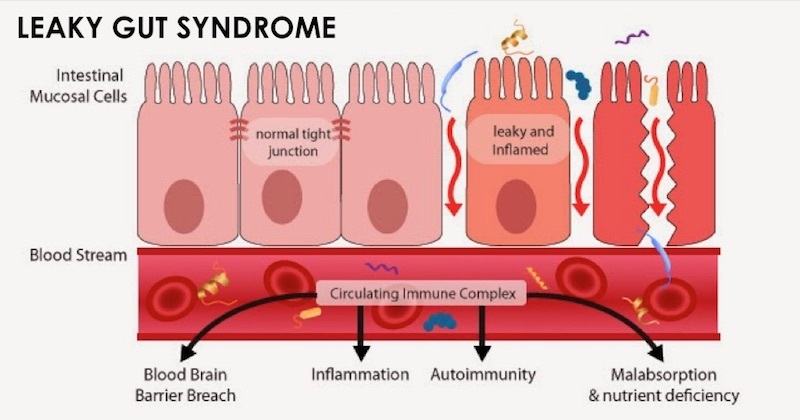
Leaky gut or “Intestinal Permeability”.
This syndrome develops because of intestinal lining damage. When damage occurs in the intestinal lining, there’s not enough protection for the internal environment to filter the nutrients and biological substances.
Due to the lack of prevention, bacteria, toxins, undigested fats and proteins, and waste can’t normally be absorbed, so it will “leak” out of the intestines and flow into the bloodstream. This process will trigger an autoimmune reaction, leading to several uncomfortable symptoms including;
Digestive issues such as bloating, diarrhea, gas, and irritable bowel syndrome (IBS).
Hormonal imbalances i.e. PCOS or PMS
Seasonal allergies
Autoimmune diseases such as thyroid conditions, celiac disease, psoriasis, and lupus
Fibromyalgia
Skin issues including acne, eczema
Type 2 diabetes
Food sensitivities
Ways that we can heal include reducing stress and becoming comfortable with our emotions but also increasing
Butyrate- ghee, bone broth
L-glutamine
Aloe vera juice
Fish oil
Slippery Elm: It contains mucilage which stimulates nerve endings within the intestinal tract to improve natural mucus secretion. This supplement helps protect the lining and even fights against excess acid and ulcers.
Marshmallow Root: Marshmallow root can be used for digestive or respiratory relief. Just like slippery elm, marshmallow root contains a high mucilage content. Marshmallow root reduces inflammation in the stomach lining, treats constipation and diarrhea, and heals ulcers by creating a protective lining within the digestive tract.

SIBO: Small Intestinal Bacterial Overgrowth
This condition occurs when there is excessive bacteria in the small intestine. Our digestive tracts are home to many different bacterium however, the small intestine is not supposed to contain as much bacteria as the colon. When bacteria build up occurs, SIBO may be to blame and SIBO symptoms can occur. The small intestine is where food combines with digestive juices and then where nutrients go on to be absorbed into our bloodstream. With SIBO, malabsorption can occur. This is especially true for fat-soluble vitamins as well as iron.
Symptoms
There are many symptoms associated with SIBO, and many of them can mimic other gastrointestinal disorders. For this reason, if you have any of the following symptoms it’s best to get tested for SIBO.
Nausea
Vomiting
Diarrhea
Bloating
Malnutrition
Weight loss
Joint pain
Fatigue
Skin conditions such as acne, eczema, and rashes
Asthma
Depression
Consuming small amounts of food at meal times
Antimicrobial supplements
Probiotic rich foods
Probiotic supplementation
Chewing your food thoroughly.
Stay hydrated and reduce stress
Week 10 - Thyroid
How to balance your thyroid....
Signs your thyroid maybe out of balance;
• Cold Intolerance- cold hands and feet
• Fatigue, “Chronic Fatigue”
• Dry Skin
• Constipation
• Difficulty Losing Weight (unable to metabolise calories and too tired to exercise)
• Fluid retention
• Depression
• Memory loss
• Anxiety, irritability
• Insomnia
• Joint aches
• Muscle Aches
• Thinning hair
• Hoarseness
• Weakness
• Breast Cancer
• Early Miscarriage
Hypothyroidism: Vata pushing Kapha
Hyperthyroidism: Vata pushing Pitta
1. Decrease inflammatory foods;
Pesticides - glyphosate
Gluten (*quick-dried with glyphosate in U.S.)
Corn
Dairy (*Grass fed raw can reduce inflammatory effects)
Processed Foods
Refined Sugar
Alcohol
Fully avoid soy, canola and millet
For some: Eggs, legumes, nuts/seeds, nightshades (Lectin-related inflammation)
Cook/avoid goitrogens (cruciferous veggies) - Disrupt production of thyroid hormone by interfering with iodine uptake
The Plant Paradox - Dr. Steven Gundry
2. Increase Nutrient-dense foods
Organ meats- fresh, frozen or dried (Paleovalley)
Pasteurized Eggs
Cod Liver Oil, Salmon, Sardines, Oysters (never farmed)
Soaked legumes, nuts and seeds (more absorbable when soaked)
3. Avoid/Reduce Toxic Exposure
Environmental- house products, toiletries, makeup
Filtered water
Avoid plastic, aluminum wrapping and containers
Remove metals from dental work
4. Lifestyle Changes (This trumps all other intervention)
Quality Sleep
Exercise/Movement- Walk in am, Interval Training/Cut back if over-training.
5. Mental-Emotional Stress
When did they start noticing these sensations?
What else was happening then?
What have you not been expressing? Where are you hiding your truth?
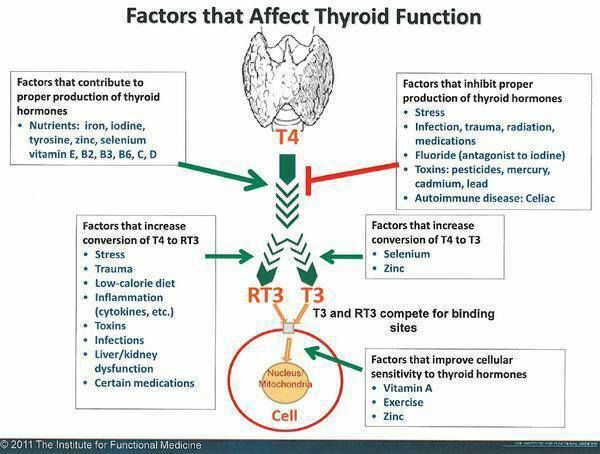
Week 11 - Chakras
Finding balance for enlightenment....
The traditional Chakras are named below and in the line with spine.
1. Muladhara (Mooladhara) Chakra
Also called Root Chakra, Red Area of the aura
Located at Guda sthanam (anal region) – Root of the spine, below the most bottom part or tip of the back bone
Anatomical equivalent:Spinal portion of Lumbar Plexus, Outer portion of Pelvic Plexus, Pelvic plexus of Sympathetic nerves or Autonomous system
Affirmation for balance “I am strong, supported, and abundant.”
It is connected to the earth and associated with everything that is necessary for survival: finances, food, shelter, self-defense, and nurturing relationships.
Journal prompt : How safe and secure do I feel?
2. Swadishtana Chakra
Also called Sacral Chakra,
Orange Area of the aura
Located at Linga sthanam or Linga mulam (root of genitals or genital area)Few inches below the navel and slightly above the pubis (root of genital organs)
Anatomical position:Spinal portion of Lumbar plexus, outer portion of inferior mesenteric plexus Hypogastric Plexus
Affirmation for balance "I am the creator of my entire reality."
It is associated with reproductive organs and is therefore deeply connected to creation, creativity, joy, sensuality, and passion.
Journal prompt : How freely do I allow myself to express my creativity?
3. Manipura Chakra
Solar Plexus,Yellow Area of the aura
Located at Naabhi (navel)Around the navel, few inches above and below the navelAnatomical position:Spinal portion of the sympathetic centre in lower dorsal section of spinal cord Solar Plexus Plexus of Coeliac axis
Affirmation for balance "I am worthy of pursuing my passion and purpose"
This chakra represents your sense of self, willpower, self-confidence, purpose, and wisdom."
Journal prompt: How free do I feel to pursue my passion and purpose?
4. Anahata Chakra
Also called Heart Chakra or Green Area of the aura Located on the spine, at the level of Hridaya (Heart) Chest, in the region of the heart
Anatomical composition:Spinal portion of upper dorsal section of spinal cord, outer portion of cardiac and pulmonary plexus, Cardiac plexus (of the sympathetic)
Affirmation for balance "I am love, I give love, I am open to love."
The Heart Chakra is associated with unconditional love (for self, others, and the earth) and is the embodiment of compassion, empathy, and centeredness.
Journal prompt: How freely do I allow myself to be receive as well as give love?
5. Vishuddha Chakra
Also called Throat Chakra or Blue Area of the auraLocated on the spine, at the level of Kanta (Throat). In the region of throat.
Anatomical composition:V ital centers in the Medulla, Upper parasympathetic system, Pharyngeal plexus (of sympathetic)
Affirmation for balance "I am in alignment with my truth. I speak with clarity and intention"
This chakra allows you to express yourself and your authenticity with your voice as your vehicle.
Journal prompt: Where am I diminishing my truth?
6. Agna Chakra or Ajna Chakra
Also called Brow Chakra or Indigo Area of the aura
Located at the level of Bhru Madhya (between Eye Brows) Between the eyebrow, in front of the center of the forehead
Optic Thalami Plexus of command The Naso-cietiary extension of the cavernous plexus of sympathetic
Affirmation for balance " I am in connection with my spirit and I trust my intuition."
It allows you to see both inner and outer worlds clearly and with insight. It is the seat of wisdom and the center for processing and understanding all that is happening within and around you.
Journal prompt: Where is my intuition trying to guide me? Where am I ignoring my intuition?
7. Sahasrara Chakra (Sahasrara Padma)
Also called Crown Chakra or Violet Area of the aura
Anatomically located at center of the cranium, in between saggital and coronal sutures of the skull
Affirmation for balance "I am one with the divine. I honor the divine within and around me"
It invites inner peace, expanded insight, deep trust, liberation and ultimately enlightenment.
Journal Prompt: Do I allow myself to see the divine in me and all around me?
Week 12 - Sleep
Sleep well
Things to consider this week;
- How stable is your night time routine?
- How could you improve it
- Is your sleep showing you signs of a dosha imbalance?
- How might you approach this
Also see below a bedtime drink recipe to help you sleep like a baby!
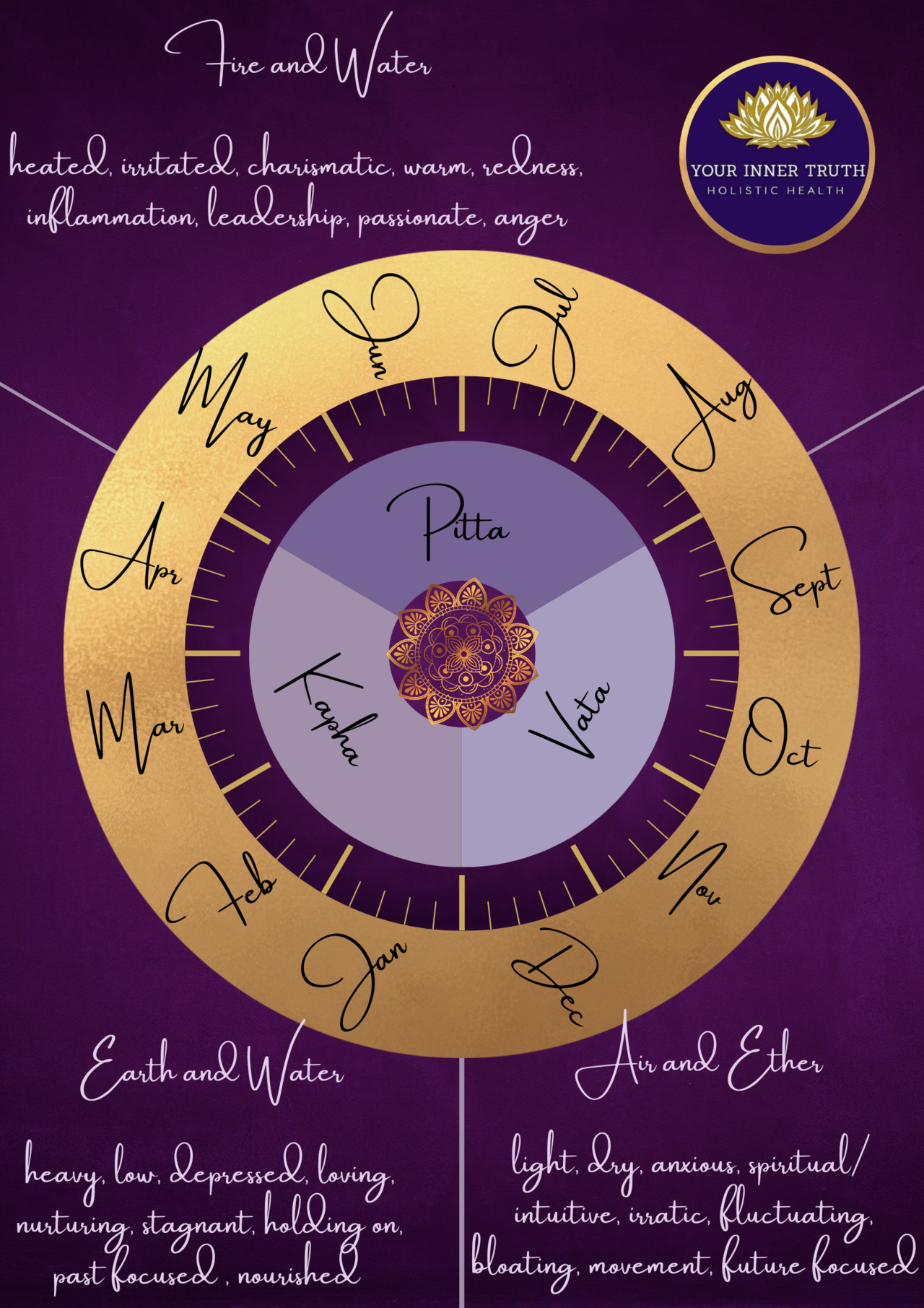

Golden milk for sleep
Ingredients:
2 cups milk (whole, coconut, almond, etc.)
1 1/2 tsp. ground turmeric
1/2 tsp. cinnamon
1 1-inch piece of fresh, peeled ginger
1 tbsp. honey or maple syrup
Directions:
Warm the milk, turmeric, cinnamon, ginger, and honey or maple syrup in a small saucepan until it simmers hot.
Whisk well to dissolve spices and divide into two mugs.
fights inflammation
protects against oxidative damage and sleep deprivation
promotes relaxation and lowers anxiety levels
Break week

It's time to review!
invite you to take this week to take stock, review what we have covered and set your intentions for the next few weeks ahead.
Just a reminder - there are no group calls this week.
Week 13 - Working with the cycles
Start planning for your year ahead.....
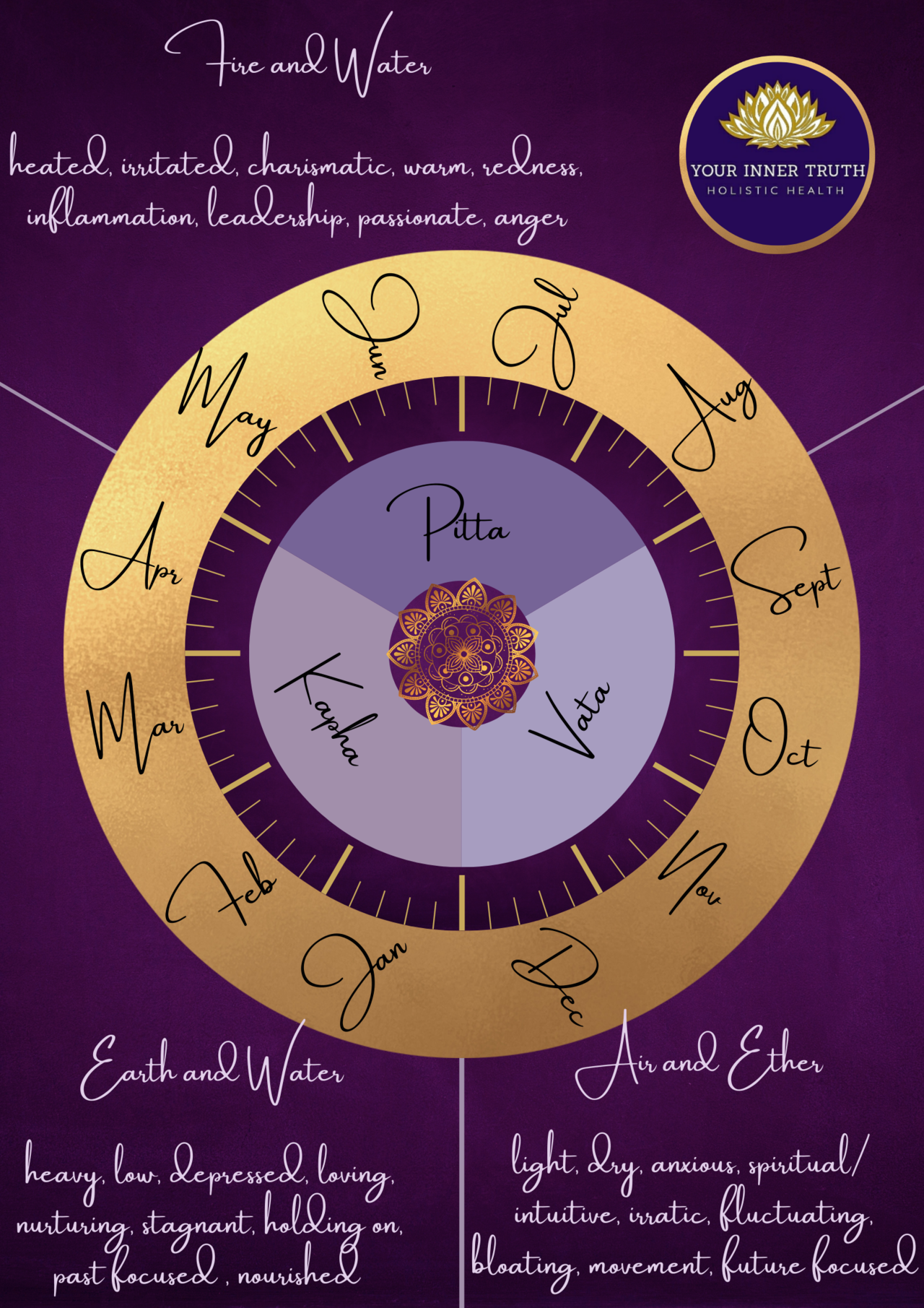
As the energies change throughout the year how might you plan to stay in balance? Consider.....
- How might I adapt my Dinacharya throughout the seasons? What will it look like for each season and how will I transition in a way that keeps me feeling safe and secure?
- How might I adapt my lifestyle during the different seasons? I.e. how will I move my body? How can I adapt my work load or working hours? When will I take holidays? When might I cut back on socialising or socialise more? What meditations might I focus on? What leisure activities might I enjoy?
Download your plan below.....
Week 14 - Aligning to the Moon cycle
Working with the natural rhythms
Take it easy and turn inward - your intuition is high
Activities; meditation, breathwork, walking, time in nature
Foods (grounding and building); lentils, almonds, rice, leafy greens, dandelions, sweet potatoes, turmeric, buckwheat, dark chocolate, avocados, black beans, organic red meat, nuts and seeds,
nettles, seafood, beets, flax seed, pistachios, licorice, ashwaganda
*You may need to eat more during this phase
Avoid; caffeine, alcohol, sugar (including natural sweeteners)
Now is the time set your intentions, dream big, and start taking action
Activities; increase movement, dancing, jogging, time in nature
Foods; ground flax, pumpkin seeds, broccoli, sauerkraut, fermented foods,
onions, leafy greens, lemon, fresh produce, quinoa, olive oil, coconut oil, chickpeas, oysters, seeds, turmeric, ginger, lighter fresher foods
* cut back a little on the carbs
You are likely to feel great and able to take on the world - connect to gratitude and self love to stop the fire burning you out
Activities; cardio, HIT workouts, social events, talking to others, network
Foods; bone broth, leafy greens, broccoli, cauliflower, cabbage, kale, bok choy, fermented foods, millet, quinoa, berries, lean protein, tuna, seaweed , sunflower seeds, mint tea
*take a break from dietary supplements
This is the perfect time to see through the chaos - review and let go of what is no longer serving you. Maintain positive practices so you are not
dragged down
Activities; Get outside in nature, gardening, read and listen to uplifting books, movies and podcasts
Foods; cucumber, melon, dark chocolate, root veg, dark berries, ghee/butter, leafy greens, sweet potatoes, red meat, dates, treat/joy food, rice, peppermint tea, cinnamon
*drink lots of fluids
Avoid;
*limit caffeine, salt and alcohol intake
Week 15 - Mantras
How to use....
The Benefits of Chanting
1. Can be soothing to the body and mind working on a consciousness and cellular level
2. Releases negative thought loop patterns
3. Can reduce anxiety, depression and lift emotional mood
4. Stirs ompassion and connects to love
5. Supports overall wellness, immunity and balances doshas
6. Invites intuition and Divine guidance
7. It increases radiance and magnetism
8. It is empowering and clears the throat chakra
9. Can be a preparatory portal for meditation and improve focus
Mantra Therapy for Balancing the Vata Dosha
The Vata Dosha is made of air and ether, therefore, to bring balance to Vata we must add chants and mantras that vibrate with more earth and water energy. Warming energy is also balancing.
Sounds that are grounding, warm, soothing, calming, gentle, slower, sweet, and rhythmic are best. Below are some chants that really support the Vata Dosha.
Basic Seed and Shakta Chants for Vata:
Vam (Vum), Lam (Lum), Gam (Gum), Klim (Kleem), Shrim (Shreem), Hrim (Hreem)
Aum Kleem Shreem Hreem Namaha
Vum, Lum Aum
Mantra Therapy for Balancing the Pitta Dosha
The Pitta dosha is made mainly of fire and little water; therefore, to bring balance to Pitta we must add chants and mantras that vibrate with the more cooling energy of the earth, water and the sweetness of love or the air element.
Sounds that are cooling, soothing to the mind, calming, gentle, slower, sweet, and rhythmic are best. Below are some chants that really support the Pitta Dosha. Also, silent chanting is a good option for Pitta.
Basic Seed and Shakta Chants for Pitta:
Vam (Vum), Lam (Lum), Yam (Yum) Shrim (shreem), Aim
Aum Shreem Aim Namaha
Vum, Lum Aum
Mantra Therapy for Balancing the Kapha Dosha
The Kapha dosha is made of earth and water, therefore, to bring balance to Kapha we must add chants and mantras that vibrate with more air and ether energy.
Basic Seed and Shakta Chants for Kapha:
Ram (Rum), Yam (Yum), Ham (Hum), Aum (Om), Hrim (Hreem), Shrim (Shreem)
Aum Aim Hreem Shreem Namaha
Rum, Yum, Hum, Aum
“When sound, breath, and awareness come together, it becomes light…So Hum meditation properly practiced leads to the union of the individual with the universal Cosmic Consciousness. You will go beyond thought, beyond time and space, beyond cause and effect.Limitations will vanish.”Dr. Vasant LadSO HUM (SILENT BREATH MEDITATION) AS TAUGHT BY DR. LAD
So Hum Meditation has existed in India throughout the ages. It synchronizes the movement of the breath with the mantra that fits naturally into the inhalation (So) and exhalation (Hum). So is felt and said mentally during the whole phase of inhalation and Hum during the exhalation. The literal translation of So Hum is “I am that,” while the deeper meaning is “I am that pure awareness.” This mantra calms the mind, yet simultaneously focuses and sharpens it. How to Practice:Begin by taking several slow, deep breaths, establishing yourself in the practice of Full Yogic Breath. When you are ready to practice So Hum, shift your awareness as follows. As you breathe in, feel that you are beginning the inhalation at the base of the spine. With the inhale, draw your awareness up the front of the body, along the midline, to the center of the brain. Mentally chant “So” during this inhalation. When you reach the top of the inhale, hold the breath in a short retention.As you breathe out, mentally chant “Hum.” Visualize the breath leaving the center of the brain, moving down the throat and returning to the base of the spine along the midline of the back of the body. When you reach the bottom of the exhale, pause before beginning.
Here's a link to hear how it should sound....https://open.spotify.com/track...
GAYATRI MANTRA
Pronunciation: Om bhur bhuvah svah | tat savitur varenyam | bhargo devasya dhimahi | dhiyo yo nah prachodayat ||
Translation: (by Zoë Slatoff-Ponté)
Earth, Heaven, the Whole Between.
The excellent divine power of the Sun.
May we contemplate the radiance of that god,
May this inspire our understanding.
Why chant it:
This is one of the oldest Sanskrit mantras. It speaks to the unity of all creation, despite its many forms. Chanting it invokes the light of the sun and helps us to transcend suffering.
Here's a link to how it should sound.....https://open.spotify.com/track...
Week 16 - Continuing your Journey
Where are you going with this?
Journal prompts to help you on your journey;
- What is the next step for me with Ayurveda?
- How can I keep what I have learnt live?
- What ongoing practices am I committing to ongoing?
- What support might I need to keep this going?
Make sure to spend some time creating your promise to yourself - and put it somewhere you will see it everyday. Keep it live, review it each month to ensure it feels relevant and still aligned to you.
Lastly thank you for sharing this journey with me. Thank you for taking the time and effort for yourself and I cannot wait to hear what you plan to do next.







